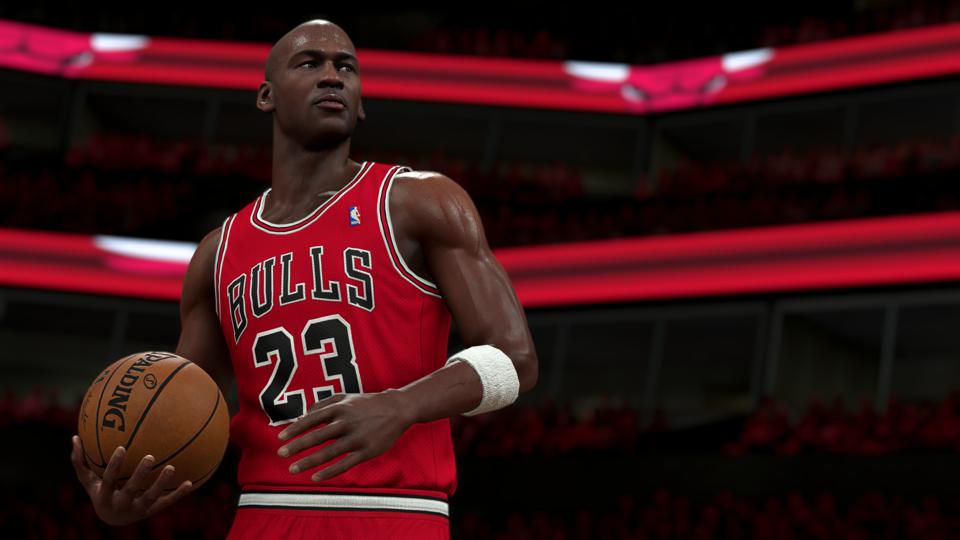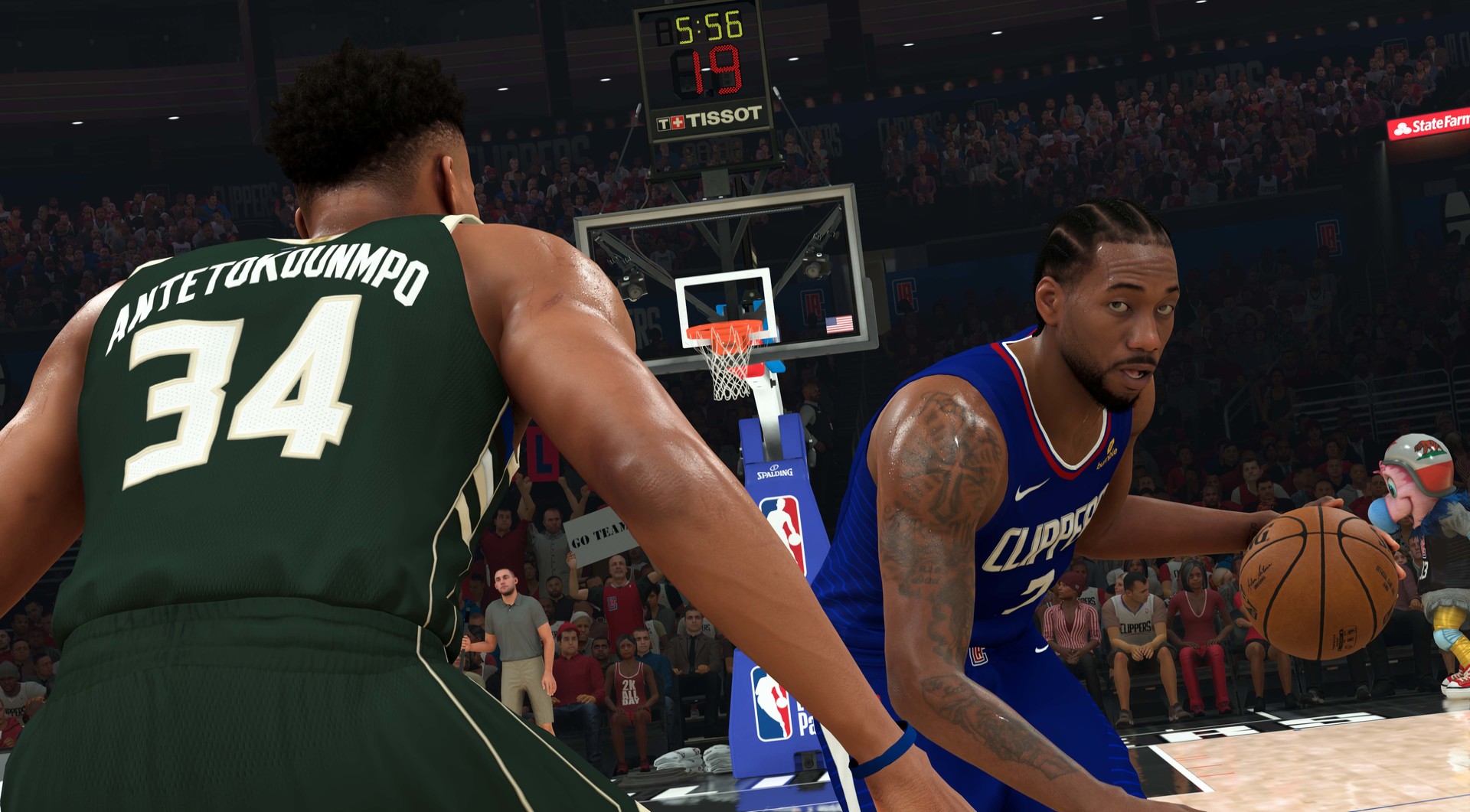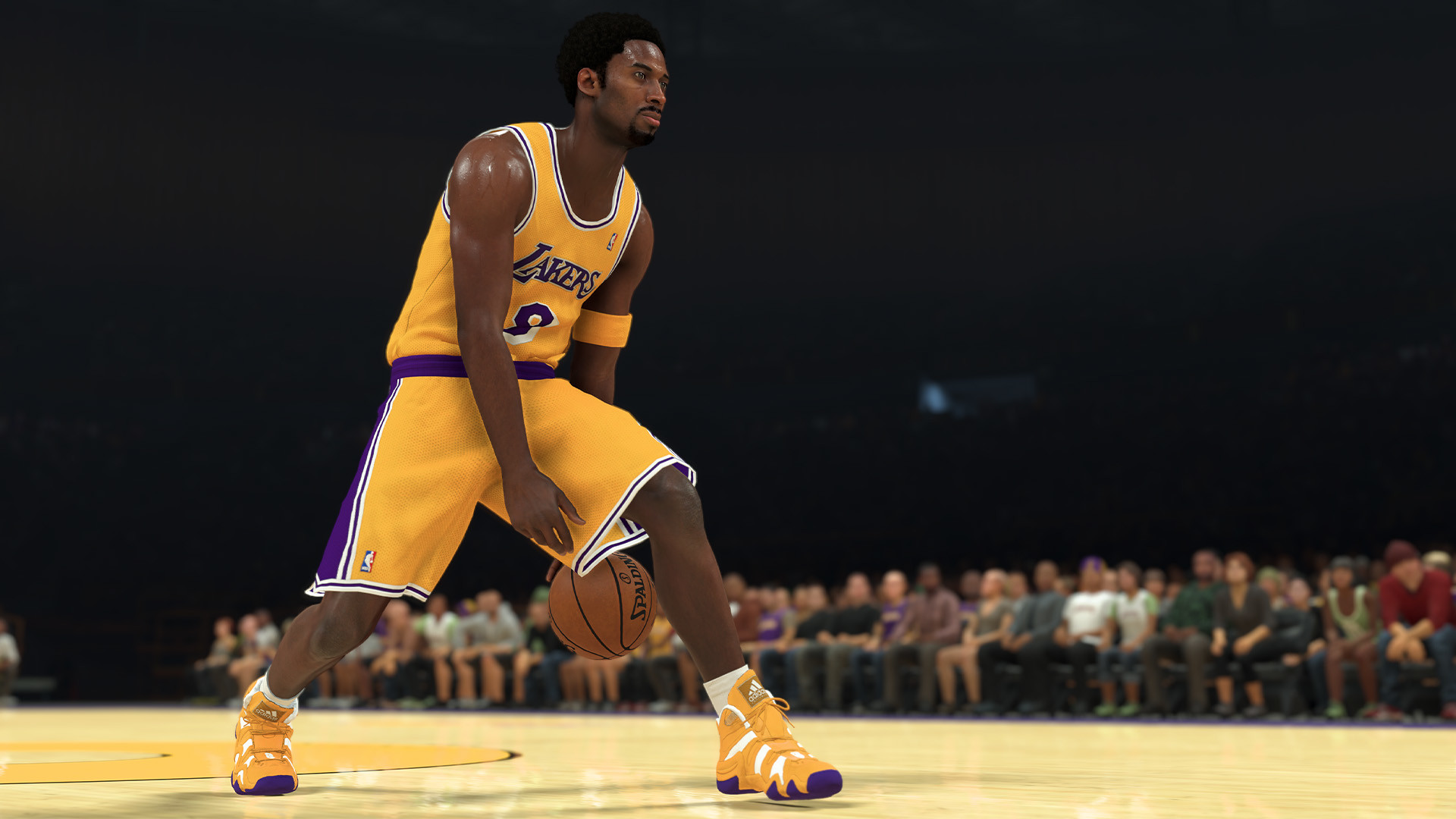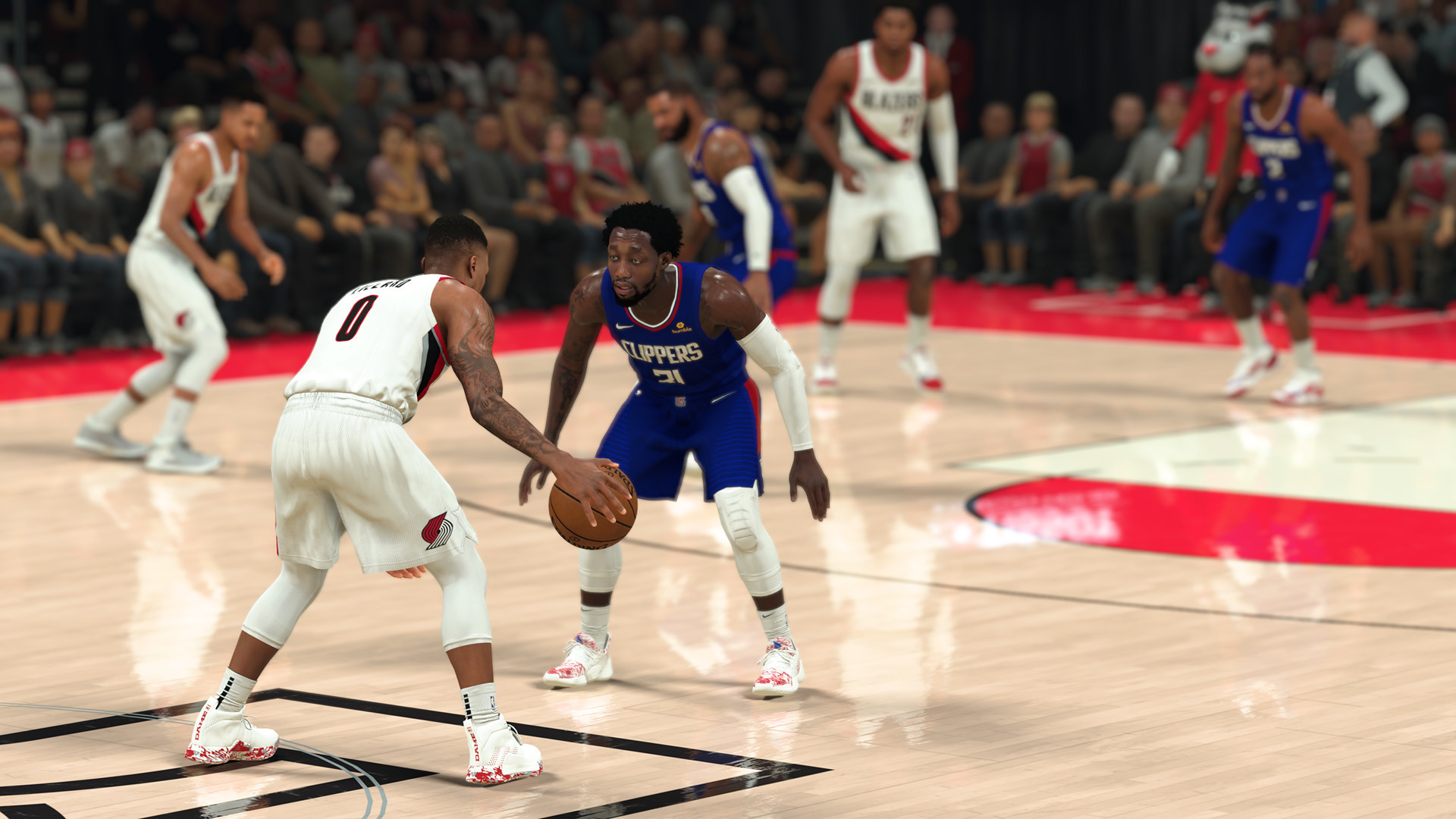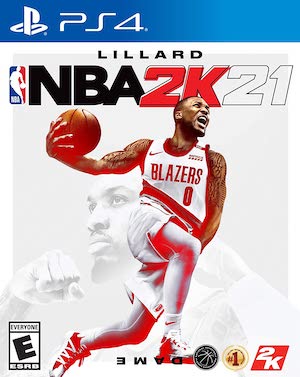
When it comes to sports game franchises, the NBA 2K series is one of the most consistent and important annual releases. It’s so perennially popular that it’s almost synonymous with the name “2K” itself, boiling down a big-name publisher to a single game. In a lot of ways, even though EA has a stranglehold on a handful of other sports, the NBA 2K series is the genre leader, pushing gameplay innovation, broadcast design, and mode differentiation that have become universal in sports games. For 2K21, though, a few quality-of-life improvements and tweaks to existing modes aren’t enough to overcome the feeling that it’s mostly unchanged year-over-year, and gameplay changes range from unnecessary to downright detrimental. While the characteristics of the franchise are still present for NBA 2K21, it doesn’t put itself in Hall of Fame contention compared to its predecessors.
In its off-the-court presentation, NBA 2K21 is as impressive as always. The broadcast is as true-to-life as ever, and players are immediately recognizable in both their character models and their signature shooting motions. While animations are mostly familiar, and it did sometimes feel like I’ve seen these halftime shows before, there are a few new touches like James Harden’s one-legged three-pointer and some new pregame introductions.
"While the characteristics of the franchise are still present for NBA 2K21, it doesn’t put itself in Hall of Fame contention compared to its predecessors."
It’s also surprisingly up to date with the issues affecting the NBA in real life. Some courts have “Black Lives Matter” printed on them as they do in the bubble, and, while it doesn’t have the courts from the current playoffs, there are references to current events everywhere, from missions in MyTeam to recreate Jamal Murray’s 50-point outing from this year’s first round to acknowledgements of next season’s delay due to the pandemic in future seasons of MyGM. Its inclusion of the WNBA in both Quick Play and Season modes, too, while not brand new for the franchise, is a nice way of including the women’s game and its superstars.
On the court, gameplay is pretty similar to past iterations, but there is a mixed bag of noticeable changes. Most prominent is the evolution of the shooting meter to the Pro Stick. On the surface, this change makes a lot of sense. The right stick doesn’t just mirror the face buttons anymore. Instead, it’s a way to emphasize release point. The meter starts centered, and the right stick controls a line along the meter. You want to move the line so it’s at the center of a grey area, which changes depending on the type of shot you take and the amount of coverage. If you’re at the center when the player shoots, you get a perfect release.
This forces you to be more cognizant of where you’re shooting from and adjust accordingly. If you do opt to use the face buttons to shoot, the mechanic is closer to past games, but it still requires you to adjust to your situation and notice timing. I really like this idea in concept because it offers both a more realistic way to look at shooting and a new learning curve for experienced players to overcome. And when you get a perfect release, it’s a rewarding sign that you made it work and had a release point that mirrors something that would work in real life.
"On the court, gameplay is pretty similar to past iterations, but there is a mixed bag of noticeable changes."
But in practice, the new way of shooting is too clunky and inconsistent for its own good. For starters, the on-screen meter is incredibly small, and the area to get a perfect release is almost invisible. The grey area that constitutes the “slightly left” or “slightly right” release is noticeable, but a lot of times even the best shooters miss the easiest shots with a release just off of center. It had me guessing where the best spot was and, more often than not, getting frustrated that I missed yet another open three where I thought I released well. While it does make you buckle down and learn its quirks, the new system changes a lot of the dynamic of how the game is fundamentally played, and it often took my focus off of the strategy of the game to focus on something that should be less important.
Even with my best shooters, I lost confidence that they could make any given shot because the Pro Stick is so inconsistent, especially in online games. Even after over 15 hours with the game, I was still struggling to consistently make shots I would undoubtedly make in past games, which forced me to push the ball to the post and force unintended drives for higher percentage shots that move away from both what I want to do on a given possession and what the real game looks like right now. It’s frustrating to have a change alter how a lot of games are played, and, while you can change this in the options menu, it’s clear that this is how the game is intended to be played.
Elsewhere on the gameplay front, there aren’t many other changes. Its best aspects are still as good as they’ve always been, and it’s still as realistic a basketball sim as you’ll find on the market. The AI is usually smart, balancing a delicate line between allowing you to make plays for yourself and not letting it feel like you’re the only player, though it can become noticeably unrealistic at points. AI-controlled defenders on your team rarely fill the lane to stop fastbreaks, and teammates will almost never set a screen for you unless called for, resulting in weird interactions where the two of you run parallel for a bit too long. Also sometimes inconsistent is your teammate grade, which can be finnicky in its determination of a defensive breakdown or a bad shot selection. With that said, the teammate grade is still mostly impressive, rewarding even small positive actions that may not show up on the stat sheet but are invaluable to the team nonetheless.
"In practice, the new way of shooting is too clunky and inconsistent for its own good."
As is expected from a new 2K, the MyCareer mode has a brand-new story that takes you through your academics and to the Association. This year’s story, titled “The Long Shadow,” puts you in the shoes of the son of a former NBA star. After not having played basketball until your senior year of high school, you take the reins to lead your school to a state championship before choosing one of 10 NCAA programs, from which I chose Texas Tech. The college journey is the longest stretch of storytelling, where you’ll rise from a low second-round pick to a top draft prospect, alongside choosing an agent, dealing with your dad’s legacy, and managing a relationship. Along the way, you’ll have a handful of choices to make. Some, like a dialogue choice here or there, are relatively insignificant to the plot, but some, like choosing your agent or answering questions at the Combine, have tangible impacts on your future as an NBA player.
While it’s not the best NBA 2K story mode of all-time, it is surprisingly well-written and was the one thing I wanted to keep coming back to before I got to the NBA. Some of the subplots are relatively underbaked: the love interest plot comes and goes in a matter of a few cutscenes, and a series of flashbacks doesn’t really make an impact. But it does a great job at letting you relate to your character and see how he’s affected by his dad’s legacy and his surroundings. Cutscenes, though often predetermined regardless of your actual performance in past games or at the Combine, are top-notch, and they expectedly draw a few high-profile cameos from the likes of Damian Lillard and Zion Williamson. Once you get to the NBA, the journey is a pretty standard fare of reaching higher goals, both on and off the court, but the path to get there is one of 2K21’s highlights.
On the flip side of MyCareer is MyTeam, NBA 2K’s answer to the Ultimate Team modes in EA’s sports games. If the MyCareer mode is the story, this is the endgame, and there are a bunch of improvements over last year that make MyTeam relatively fresh to restart. You can still play online against real people in either pickup games or in structured tournaments and leagues, or you can play offline against computer-controlled teams to complete challenges or unlock bigger and better stars. I came to enjoy the offline Triple Threat mode because of its laid-back, Blacktop-style 3-on-3 matchup and its flashy neon court. MyTeam’s major new addition is Seasons, which works like it does in most other service-based games – think Fortnite or Apex Legends. You have events and challenges that reset on the start of a new season, and each season has its own unique rewards. Lifetime challenges carry over, but it rewards repeated play without making the game unplayable for anyone who takes a little while off.
"On the flip side of MyCareer is MyTeam, NBA 2K’s answer to the Ultimate Team modes in EA’s sports games. If the MyCareer mode is the story, this is the endgame, and there are a bunch of improvements over last year that make MyTeam relatively fresh to restart."
Also new is MyTeam Limited, which takes another hint from other service-based games. These are weekly modes that require certain parameters to play, like having a team filled with players from current playoff teams. These offer even more unique rewards, and the parameters to play are different every week. I really like the way MyTeam allows you to play many different ways, though it can get a bit overwhelming at points. There are countless ways to customize your teams, and, though it often feels lacking in direction for where to go next if you don’t have a particular route in mind, it’s certainly one of the best ways to keep progressing in this game for a longer period of time.
One thing to note regarding MyTeam, and much of the rest of 2K21 as a whole, is its continued heavy reliance on microtransactions. Many challenges in MyTeam require a particular type of player, and upgrades in other modes require a certain number of coins. If you don’t have them, you’re out of luck until you can get them. I had trouble playing the very first MyTeam Limited mode because I didn’t initially have 5 players from current playoff teams, and, while it is possible to gain packs and coins through gameplay, the game doesn’t shy away from leading you to the store to buy more card packs, which it seems to favor over organic gameplay.
Though it does organize them neatly into four umbrellas, 2K is not lacking in modes. From Quick Play to MyLeague, each umbrella leads to endless possibilities for playing basketball. Unfortunately, outside of MyCareer and MyTeam, the updates to almost any mode are pretty negligible compared to last year. The biggest change comes in The Neighborhood, which is huddled under the MyCareer umbrella. This year, The Neighborhood has moved to the 2K Beach, giving the whole thing a beachfront makeover, but mechanically it’s still just a place to play a bunch of online pickup games or roam around the impressive open world. MyGM and MyLeague are also relatively unchanged, and the Quick Play modes are almost identical to past iterations. That’s not to say that any of these modes are bad; I really like almost every single one of these modes, especially The Neighborhood, and I think they’re all innovative ways to play the game. However, it seems disingenuous to have all of these modes effectively copied and pasted from last year without significant improvements.
"One thing to note regarding MyTeam, and much of the rest of 2K21 as a whole, is its continued heavy reliance on microtransactions."
Because of its consistently great gameplay and impressive array of features, there’s effectively a floor that the 2K series can hit with its quality. With 2K21, though, it’s starting to come close. Additions to MyTeam and the brand new MyCareer story are welcome improvements, but the lack of changes to other modes and the unsuccessful new shooting make it difficult to put this iteration above past years. Despite its problems, I still really enjoy playing a game of 2K basketball, whether it’s a pick-up game or an NCAA championship, but it’s beginning to feel like the series is losing traction. It’s fitting that the NBA is playing its current games in a bubble, because the 2K series might be just about to burst.
This game was reviewed on the PlayStation 4.
New MyCareer story; MyTeam additions; Consistent year-over-year gameplay; Fantastic presentation; Occasionally rewarding Pro Stick successes.
Inconsistent and frustrating Pro Stick shooting; Unrealistic AI; Heavy reliance on microtransactions; Lack of changes for most modes.









